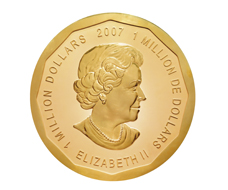by Björn Schöpe
translated by Annika Backe
March 30, 2017 – A Hollywood-style heist in one of the world’s most important coin cabinets has attracted attention throughout the globe. The victim: the Berlin Münzkabinett on the Berlin Museumsinsel (Museum Island), a UNESCO World Heritage Site. The haul: a Canadian Maple Leaf, 53 centimeters in diameter and 100 kilograms in weight. It is made from pure gold and has a face value of 1 million Canadian dollars (ca. 690,000 euros). According to the current gold price, its real value amounts to approximately 3.7 million euros.
The crime
The ‘Kommissariat für Kunstdelikte des Landeskriminalamtes Berlin’ (directorate for art-related crime of the Berlin Police) is investigating since Monday, to reconstruct the crime and catch the burglars. Given the sheer measurements and the weight of the coin, police believe that several persons were involved in the heist.
The Bode Museum. Photo: © Carschten / Wikimedia Commons / CC BY-SA 3.0 de
A police spokesman told the media that unknowns broke into the Bode Museum between 3:20 and 3:45 a.m. on March 27, 2017. From the base of the Monbijou Bridge, they climbed into the Museum through a window, using an extendable aluminium ladder. They then walked about 150 meters through the Museum, heading straight to the permanent exhibition where they destroyed, with “brutal force”, the bulletproof case in which the ‘Big Maple Leaf’ had been displayed.
Traces of an impact have been secured underneath the window on the bridge. Police spokesman Winfrid Wenzel said: “Based on this information, we are sure that the coin has fallen down from great height – three or four meters – and suffered damage.” Adding to the aluminium ladder, the investigating team also found a wheelbarrow and a rope on the railway tracks of the S-Bahn that runs alongside the crime site. Police believe that this equipment, too, was used by the burglars for transportation. They probably pushed the wheelbarrow with the coin roughly 80 meters along the railways track, across the Spree River, and, using the rope, rappelled off to the Monbijou Park where a getaway car was waiting.
Have you seen this coin? Big Maple Leaf. © Staatliche Museen zu Berlin, Münzkabinett; Photo: Reinhard Saczewski.
The haul: Big Maple Leaf
The captured coin is a very special striking by the Royal Canadian Mint. With this coin, the Mint illustrated the then state-of-the-art technology in 2007. Five specimens of the Maple Leaf had been produced and entered into the Guinness Book of Records as the world’s biggest gold coin of its time. (Since 2011, a gold coin in the weight of a ton, struck in the Australian Perth Mint, holds this distinction.) Very little is known about the whereabouts of the other four specimens. According to 2010 media reports, one is in the possession of the Queen of England, two are kept in the United Arab Emirates, and another one was acquired by Oro Direct, a Spanish gold trading company.
The fifth coin was in private hands and given to the Bode Museum on permanent loan in 2010. Thus, this specimen was probably the only one to be on public display. To the Bode Museum, it was a piece of luck for the Big Maple Leaf attracted a particularly large number of young people to the Münzkabinett.
Museum heist has reached new dimension
Since Monday, all 19 houses of the Staatliche Museen zu Berlin have further tightened up safety. How the thieves managed to overcome security systems, is not yet clear. Director-General of the Staatliche Museen zu Berlin, Michael Eissenhauer, announced in an official statement: “We are shocked that the burglars overcame our security systems, which we have successfully used to protect our objects for many years.” The burglars have proceeded with an enormous criminal energy and brutality. In the last decades at least there has been no previous incident of this kind in the entire museums community. “A heist of such a dimension constitutes a challenge for the Berlin police as well”, said a police spokesman.
The Münzkabinett staff is shaken and stunned. Nobody would have believed that the huge gold coin could be taken by perpetrators.
Actually, Director of the Münzkabinett, Bernhard Weisser, has to go back as early as 1718 to track a similar heist in the Berlin Münzkabinett. The then castellan and a blacksmith of the royal court had embezzled the collection of Frederick William I on a large scale. They were caught and subsequently quartered. The present incident raises the question whether or not the thieves had insider knowledge. The break-in was certainly well-planned. “A heist of this dimension isn’t just something an ordinary person can accomplish in passing. It requires detailed planning”, a police spokesman is quoted in the media.
The Big Maple Leaf is thought to be impossible to sell. The burglars are very likely to try to melt down the haul. That, however, is also difficult on a technical level. Police, therefore, are asking anyone to come forward if having been offered larger quantities of gold, in an unusual format. A use in every-day life is less likely, although with tongue in cheek, Berlin Transport Company, BVG, excluded it already. “In light of current events”, it announced via Twitter that the BVG ticket machines do not accept any 100 kilo coins. Police then added, also via Twitter: “But you are welcome to change any 100 kilo coins at every local police station.”
It is to be hoped that the coin will be found and the thieves caught. The Münzkabinett at any rate certainly misses the Big Maple Leaf as a crowd puller with young people already.
You can read a first interview with Bernhard Weisser in the Tagesspiegel.
And a summary of the latest information is provided by this article in the Telegraph and The Globe and Mail.







